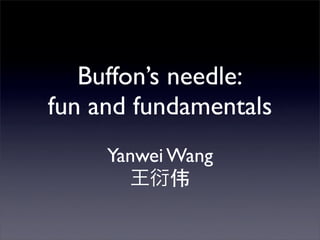
Buffon\'s needle: fun and fundamentals
- 1. Buffon’s needle: fun and fundamentals Yanwei Wang
- 2. Georges-Louis Leclerc, Comte de Buffon (7 September 1707 – 16 April 1788)
- 3. Histoire Naturelle, Générale et Particulière (1749-88, 36 volumes)
- 4. Essai d’arithmétique morale (or “Essay of moral arithmetic”)
- 5. The game of franc-carreau (The clean tile problem)
- 6. The game of franc-carreau (The clean tile problem)
- 7. The game of franc-carreau (The clean tile problem)
- 8. The clean tile problem represents the first attempt towards computing probabilities by using geometry instead of analysis. A.M. Mathai : An Introduction to Geometrical Probability: Distributional Aspects with Applications, Gordon and Breach, Newark, (1999).
- 10. • Ever helpful, Buffon points out that "On peut jouer ce jeu sur un damier avec une aiguille à coudre ou une épingle sans tête." (You can play this game on a checkerboard with a sewing-needle or a pin without a head.)
- 12. The probability that a needle (L<D) cut a line is 2L P = πD The solution required a geometrical (rather than combinatorial) approach and was obtained by using integral calculus, for the first time in the development of probability. A.M. Mathai : An Introduction to Geometrical Probability: Distributional Aspects with Applications, Gordon and Breach, Newark, (1999).
- 13. The probability that a needle (L<D) cut a line is 2L P = πD Buffon's needle problem established the theoretical basis for design-based methods to estimate the total length and total surface area of non-classically shaped objects. The field is known as Stereology.
- 14. Proc Biol Sci. 2000 April 22; 267(1445): 765–770.
- 15. The probability that a needle (L<D) cut a line is 2L P = πD In 1812, Laplace suggested using Buffon’s needle experiments to estimate π
- 16. The Monte Carlo Casino Von Neumann chose the name "Monte Carlo".
- 17. The probability that a needle (L<D) cut a line is 2L P = πD In 1812, Laplace suggested using Buffon’s needle experiments to estimate π wrong!
- 18. An italian mathematician, Mario Lazzarini performed the Buffon’s needle experiment in 1901. His needle was 2.5 cm long, and his parallel lines were separated by 3.0 cm apart. He dropped the needle 3408 times and observed 1808 hits. 1808 2 2.5 = 3408 π 3.0 ˆ 355 π= ˆ = 3.1415929... 113
- 19. An italian mathematician, Mario Lazzarini performed the Buffon’s needle experiment in 1901. His needle was 2.5 cm long, and his parallel lines were separated by 3.0 cm apart. He dropped the needle 3408 times and observed 1808 hits. 1808 2 2.5 = 3408 π 3.0 ˆ 355 π= ˆ = 3.1415929... 113 The Zu Chongzhi Pi rate, obtained around 480 using Liu Hui's algorithm applied to a 12288-gon Zu Chongzhi (429–500)
- 21. What is the average number of needle-line crossings? This version was introduced by Émile Barbier (1839-1889) in 1870.
- 22. If L<D, the number of crossing in one throw can either be 1 or 0 with probabilities P and 1-P. The throws are Bernoulli trials. 2L P = πD When a needle is dropped at random T times, the expected number of cuts is PT.
- 23. The Buffon Noodle Problem
- 24. Suppose the noodle is piecewise linear, i.e. consists of N straight pieces. Let Xi be the number of times the i-th piece crosses one of the parallel lines. These random variables are not independent, but the expectations are still additive. E(X1+X2+···+XN)=E(X1)+E(X2)+···+E(XN) Ramaley, J. F. (1969). "Buffon's Noodle Problem". The American Mathematical Monthly 76 (8, October 1969): 916–918
- 25. When a noodle is dropped at random T times, the expected number of cuts is PT. 2L P = πD where L is the contour length of the noodle.
- 26. Consider a circle with diameter, D, the same as the grid spacing. The total length of the circle (circumference) is π D. The expected number of cuts per throw is then 2 πD =2 π D
- 30. Summary • Mr. Buffon and his three classical problems • Mr. Lazzarini’s lucky estimate of π • The Buffon noodle problem • Inspirations to our research